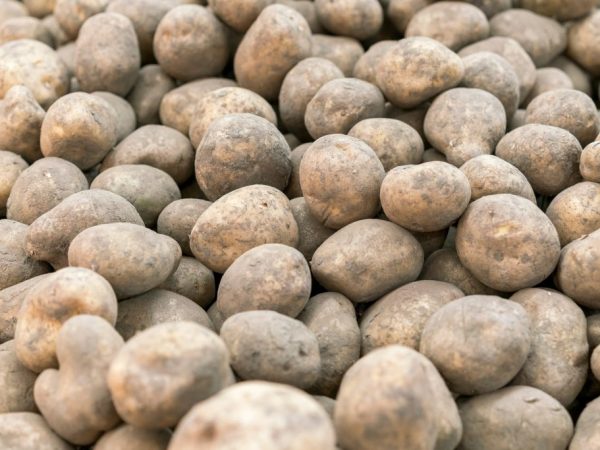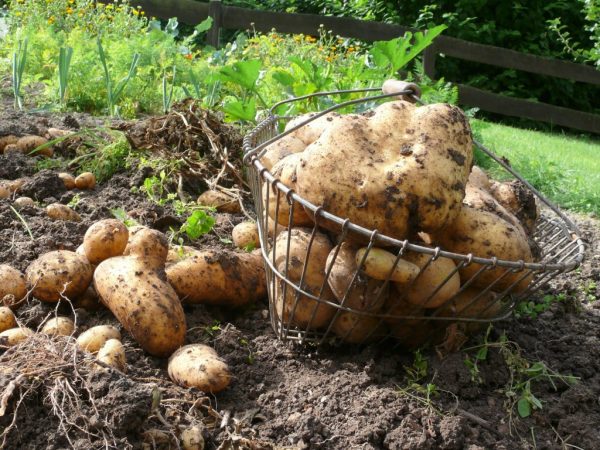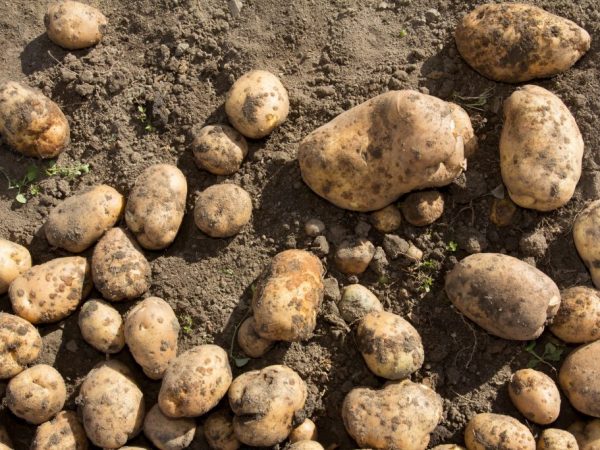How to get a good potato crop
Growing vegetables on a plot of land makes it possible to produce high-quality and inexpensive products. However, the dacha area does not always allow adhering to technological rules, which affects the yield of the variety. How to get a good potato crop? Let us examine the factors affecting the fertility of the species.

Good harvest of potatoes
Site preparation
Root vegetables have long been a favorite dish on the table of compatriots, so any free space is given to popular culture. The potato is a light-loving plant that needs a lot of sun. The more trees and fences nearby, the less tasty the product.
Anastasia Lipatova proposes to break the beds in the direction from north to south. Like strawberries, the luminary will evenly illuminate the potatoes throughout the day. Until noon, the rays will touch the eastern side of the grooves, and after 12 noon - the western side. Thanks to this trick, plantings receive maximum heat and energy, which significantly increases yields.
If it is not possible to organize the correct crop rotation, then the fertility of the site can be restored with the help of green manure. After the vegetables have been harvested, you cannot leave empty land. In August or early September, the place is sown with watercress, rye or mustard. In the second half of October, the plants are mowed, and the soil is dug to a depth of at least 18 cm. In this simple way, the soil is enriched with nutrients and disinfected.
By the way, compost beds will be relevant for small land plots. After the crop is harvested, good plant residues are harvested on the site that is planned for growing potatoes. The earth is carefully dug up together with greens and branches, leaving it until spring. By the beginning of the new growing season, the soil becomes the most nutritious for the culture.
Variety selection
Increasing the yield of a small plot is difficult without high-quality hybrids. For several years, summer residents can use their favorite variety of root crops. Gradually, such a plant degenerates - the taste characteristics deteriorate, so an update of the "model range" is required.
- Among the most inexpensive, but prolific varieties, it is worth noting the Bulletin - a mid-season universal potato that will delight you with disease resistance and give the owner a rich harvest.
- Seeds Lux and Mayak grow well on low-nutrient lands, they are not capricious to care. Excellent taste and good feedback will appeal to novice farmers.
- Among the elite varieties, Bellarosa is considered the favorite, grown in all countries of Eastern Europe. If the minimum breeding requirements are met, farmers receive 3.5 quintals from one hundred square meters. Beautiful oval tubers ripen early, so in the southern regions they harvest twice a season.
- The German variety Adretta is excellent for natural farming with a minimum of chemical additives.The most undemanding hybrid develops on both clay and sandy soils. Resistant to drought and moisture, it quickly forms good tubers - up to 140 g.
Preliminary processing

Large potatoes in pre-processing
The maximum yield of plants depends on the quality of the seeds and the pre-treatment. If there are no funds to purchase a super-elite hybrid, we advise you to thoroughly disinfect the tubers. There are several options for solutions.
- Natural. Add one kilogram of crushed garlic to a bucket of water. Raw materials are kept in moisture for at least three hours.
- Classical. Copper sulfate is mixed in 10 liters of liquid with boric acid and potassium permanganate. Substances not only kill pathogenic bacteria, but also activate metabolic processes.
- Nutritious. Urea and superphosphate are added to the classic recipe. This solution destroys fungi, while "feeding" the tubers.
- For aerosols. Potassium sulfate is mixed with urea vitriol, manganese and boric acid. Substances are dissolved in water, filtered and used for air treatment.
Bathing in special solutions is a must for root crops. It is impossible to get a good harvest without copper-based chemicals. In domestic climatic conditions, late blight spreads at the earliest opportunity. In the affected areas, not only potatoes die, but also all subsequent plants.
How to increase fertility
On a small garden plot, it is difficult to improve the quality indicators of the variety. If you are looking for a way to increase the yield of your potatoes, then it is worth trying the proven method laid out on Lipatova Canal. The increase from each bush can reach more than ten percent.
To stimulate the shoots, the tuber is cut along the entire circumference to a depth. With this option, nutrients are redirected to the lateral buds, which accelerates germination. This root crop has a larger number of stalks, which will increase the volume of production from the bush.
The transverse annular cut activates the lower dormant eyes, and the longitudinal - the upper ones. If you hold the "operated" seed at a temperature of 15 to 18 degrees for a month, the efficiency of forcing will improve. This option is easy to do in an apartment. By the way, in order to prevent infection from getting into the wounds, the tubers are disinfected in potassium permanganate.
How to plant
A good harvest of home potatoes is a well-chosen planting scheme. Summer residents are limited in usable area, so you have to place root crops in a small area where there is a free piece. The growth of the crop is influenced by the width between the rows, which should be at least 70 cm. In a narrower space, the plants lag behind in development.
If there is not enough space, then the seeds can be grown in vertical beds. A "tower" is assembled from the mesh, which is filled with layers of straw and nutrient soil. For tiny areas, we recommend experimenting with “mobile” structures such as barrels or shopping bags.

We seat in the holes
The easiest and most reliable planting method is the Dutch ridge method. Plants are provided with good air circulation, as a result of which they grow strong and healthy. The "shovel" technology familiar to the domestic farmer is still relevant, but you should not bury the tubers deeper than 10 cm, otherwise the potatoes will grow small.
Watering
No matter what summer residents say, proper watering always affects the yield of potatoes. Crops, where an important procedure takes place exclusively at the whim of nature, it is difficult to achieve maximum return. The fact is that life-giving moisture is required at different stages of the development of culture.
- After the sprouts appear. Water activates metabolic processes and helps the plant grow good roots and tops.Even a small deficit during this period will negatively affect the general condition and immunity of the potato.
- Before flowering. As soon as buds appear, irrigate immediately. Lack of moisture will cause the plant to shed its ovaries.
- Fruit formation. The final step helps the crop grow in tuber size.
“Disruption of air circulation and moisture movement will lead to the multiplication of harmful
bacteria and insects. "
To increase the yield of home potatoes, it is important to pour at least three liters of liquid under each bush. If the summer is wet, then you should not be zealous with watering, otherwise the root crops will begin to rot. Irrigation is carried out at the root or along the furrows in the evening or early morning. Daytime treatments can cause burns. Remember that excess water in the last weeks before harvesting will impair keeping quality.
Fertilizers
The original method of obtaining a record crop of potatoes in a small garden requires carefully selected nutrients from the owners. Natural farming, which Anastasia Lipatova offers, practically excludes chemical additives. Vermicompost contains all elements important for plants - nitrogen, potassium and phosphorus. A deficiency of one of the substances will always affect the quality and quantity of root crops.
The first application is carried out during the period of active growth, especially with weak, lifeless stems. Early feeding allows you to achieve good results in adding fruit. For ten meters of a potato bed, we recommend using 5 tablespoons of urea and 14 glasses of humus. By the way, an excess of organic matter can provoke the onset of diseases.
The second stage affects the intensity of flowering, therefore it is carried out during budding. A glass of ash and 50 g of potassium sulfate can be used as food sources. Substances are added to a bucket of water, after which the beds are watered.
The latter fertilizer speeds up the formation of tubers, so you should not abandon the procedure. During this period, nitrogen preparations are contraindicated, otherwise the plant will redirect forces to the formation of greenery. Now it is allowed to use superphosphate and nitrophosphate both under the root and on the leaf.
Hilling
Among the proven secrets of improving yields, not the least is the "rolling" of seeds with mounds of earth. Novice farmers often do not understand the meaning of the procedure, so they try not to use a strange method because of the banal “I don’t want to waste time”. If you have not used alternative planting methods, then you should not deprive the potatoes of the necessary development conditions.
Hilling bushes, farmers not only loosen the soil and destroy weeds. Thanks to the measures, the plant improves the air exchange of the roots and the illumination of the tops. The lower parts of the potatoes begin to actively form stolons, on which tubers will soon appear. The procedure is best done twice - after the leaves have opened and three weeks later.
How to increase fruit size
Among the secrets that help to get a big harvest in a small garden is the old method, described in detail by Anastasia Lipatova. After the plants bloom, you should wait two to three weeks. After the expiration of the term, the stems are broken at a height of up to 15 cm from the ground. It is important that the bush does not lose its integrity.
The nutrients in the tops reach the breakdown and return to the roots. The stems do not wither, so photosynthesis is not disturbed. The vital activity of the potato continues: the size of the tubers increases, and the greens cease to pull important components onto themselves.
By the way, the technique is effective only for healthy bushes. A potato stricken with ailment and insects will not have enough strength to "reorient". Sick specimens often shed their foliage and wither.
Growing potatoes in a small garden can yield excellent returns from any variety.Knowing how to get a good harvest on your own, it is easy to see all the strengths and weaknesses of the site. The recommendations provide secrets to help you achieve great results.


